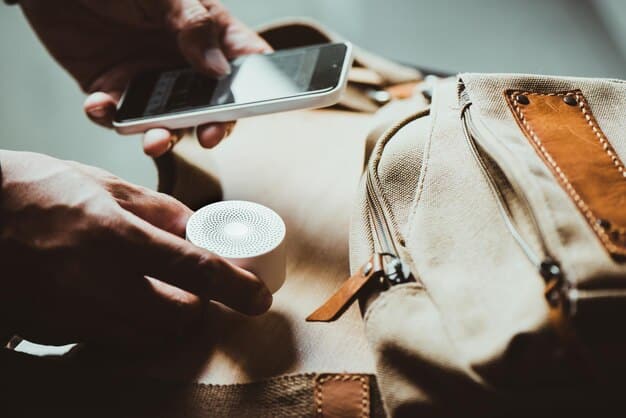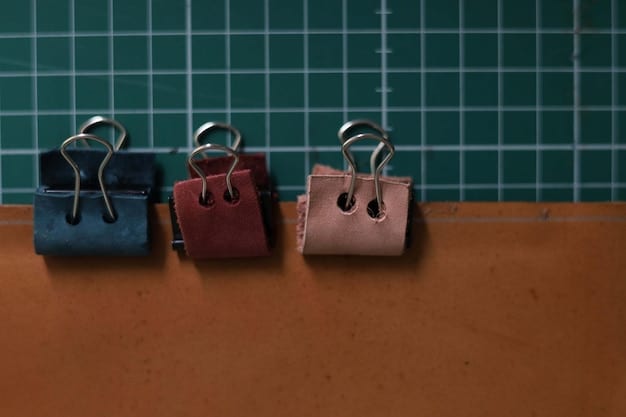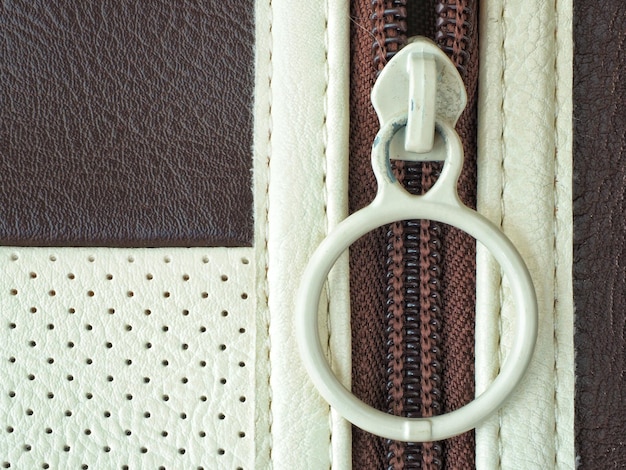Spotting Fake Fashion: How to Identify Counterfeit Items on Shopee

Spotting fake fashion on Shopee requires a keen eye for detail, including examining seller reputation, product images, pricing, and customer reviews to ensure you’re purchasing authentic clothing and accessories.
Navigating the world of online fashion shopping can be exciting, but it also comes with its challenges, especially when trying to avoid counterfeit products. This guide will delve into the crucial aspects of spotting fake fashion: how to identify counterfeit clothing and accessories on Shopee, helping you make informed purchase decisions.
Understanding the Counterfeit Fashion Market on Shopee
The appeal of branded fashion at discounted prices is undeniable, which makes platforms like Shopee fertile ground for counterfeiters. Understanding this market is the first step in protecting yourself from purchasing fake items. But why is fake fashion so prevalent, and what attracts buyers to these products?
Several factors contribute to this phenomenon. Firstly, the accessibility of online marketplaces like Shopee allows counterfeiters to reach a wide audience with minimal overhead. Secondly, many consumers are drawn to the allure of luxury brands but are unable or unwilling to pay full retail price, creating a demand for cheaper alternatives, regardless of their authenticity.
The Appeal and Risks of Buying Counterfeit Fashion
The primary appeal of counterfeit fashion lies in its affordability. Consumers can obtain items that mimic the appearance of high-end brands at a fraction of the cost. This can be particularly attractive for those who want to keep up with fashion trends without breaking the bank.
However, the risks associated with buying counterfeit fashion far outweigh the perceived benefits. Some of these risks include:
- Poor Quality: Counterfeit items are often made from inferior materials and lack the craftsmanship of genuine products, leading to durability issues and a shorter lifespan.
- Ethical Concerns: The production of counterfeit goods often involves unethical labor practices and contributes to criminal activities such as money laundering.
- Health and Safety Risks: Fake clothing and accessories may contain harmful chemicals or materials that can pose health risks to the wearer.
- Legal Implications: Purchasing and possessing counterfeit goods can sometimes have legal consequences, depending on the jurisdiction.

Red Flags: Key Indicators of Counterfeit Items on Shopee
Detecting counterfeit fashion requires a keen eye and attention to detail. While counterfeiters are becoming increasingly sophisticated, there are still several red flags that can help you identify fake items. These indicators range from scrutinizing seller profiles to closely examining product details.
Being vigilant and informed can significantly reduce your chances of falling victim to counterfeit products. This section outlines the key indicators to watch out for when shopping for fashion items on Shopee.
Seller Reputation and Ratings
One of the first things to check is the seller’s reputation and ratings. Look for sellers with a high number of positive reviews and a good overall rating. Be wary of sellers with few or no reviews, or those with a significant number of negative reviews.
Additionally, check the seller’s history and activity. How long have they been selling on Shopee? Do they have a wide range of products, or do they primarily sell items from a single brand? A seller specializing in multiple high-end brands may be a red flag.
Product Images and Descriptions
Carefully examine the product images provided by the seller. Are the images clear and high-resolution? Do they show the item from multiple angles? Be suspicious of blurry or low-quality images, as these may be a sign that the seller is trying to hide flaws or discrepancies.
Read the product description carefully. Does it accurately describe the item? Are there any spelling or grammatical errors? Vague or poorly written descriptions can be a sign of a fraudulent seller.
Examining Pricing and Discounts
Pricing is often a telltale sign of counterfeit goods. Authentic designer items rarely go on sale for deep discounts, so if a price seems too good to be true, it probably is. It’s essential to compare prices across different sellers and platforms to get a sense of the average market value.
Be particularly cautious of items that are significantly cheaper than the retail price or are offered at steep discounts that are not consistent with the brand’s usual sales practices. While legitimate sales do occur, extreme discounts should always raise suspicion.
Comparing Prices Across Platforms
Take the time to compare the price of the item on Shopee with prices on other reputable platforms, such as the brand’s official website or authorized retailers. This can give you a good indication of whether the price on Shopee is realistic.
If the price on Shopee is dramatically lower, it’s a strong indication that the item is counterfeit. Keep in mind that even during sales, authentic designer items are unlikely to be discounted by more than a certain percentage.
Questionable Discounts and Promotions
Be wary of sellers offering unusually large discounts or promotions, especially if they seem out of line with typical retail practices. Counterfeiters often use these tactics to lure in unsuspecting buyers. Some things to watch out for include:
- Limited-time offers that create a sense of urgency.
- Discounts that are significantly higher than those offered by authorized retailers.
- Promotions that seem too good to be true, such as “buy one get one free” deals on luxury items.
Analyzing Product Details and Materials
Authentic fashion items are known for their high-quality materials and impeccable craftsmanship. Counterfeiters often cut corners by using inferior materials and paying less attention to detail. Therefore, scrutinizing the product’s materials and construction is crucial in identifying fakes.
From examining the stitching to checking the hardware, every detail can provide clues about the item’s authenticity. This section delves into the specific aspects to consider when evaluating the materials and construction of fashion items.
Stitching, Seams, and Hardware
Check the stitching and seams of the item. Authentic items will have neat, uniform stitching with no loose threads or uneven seams. Counterfeit items often have sloppy or irregular stitching.
Examine the hardware, such as zippers, buttons, and buckles. Authentic items will have high-quality hardware that feels solid and durable. Counterfeit items often have cheap, flimsy hardware that is prone to breaking.
Logos, Labels, and Authenticity Cards
Carefully inspect the logos and labels on the item. Authentic items will have clear, precise logos that are correctly positioned and aligned. Counterfeit items often have poorly printed logos with errors in spelling or design.
Check for authenticity cards or certificates. While these can be faked as well, their presence (or absence) can be another factor to consider. Authentic items often come with a card that includes information about the item’s materials, care instructions, and serial number.

Leveraging Customer Reviews and Feedback
One of the most valuable resources for identifying counterfeit fashion on Shopee is customer reviews and feedback. Reading what other buyers have to say about their experiences can provide insights that aren’t apparent from product descriptions or images.
However, it’s essential to approach reviews critically. Look for patterns in the feedback, and be aware that some reviews may be fake or biased. This section will help you navigate customer reviews and use them effectively to identify potential counterfeit items.
Analyzing Review Patterns
Look for patterns in the reviews. Are multiple customers complaining about the same issues, such as poor quality, incorrect sizing, or discrepancies in the product description? If so, it’s a red flag.
Pay attention to the language used in the reviews. Generic or overly positive reviews may be fake. Look for reviews that provide specific details about the item and the buyer’s experience.
Identifying Fake or Biased Reviews
Be aware that some reviews may be fake or biased. Sellers may pay for positive reviews to boost their ratings, or competitors may post negative reviews to damage their reputation.
Look for reviews that seem too good to be true or that lack specific details. Also, be wary of reviews that are overly critical or that seem to have an agenda.
Shopee’s Policies and Buyer Protection
Shopee offers various policies and buyer protection programs designed to safeguard customers from fraud and counterfeit goods. Understanding these policies and how to use them is essential for ensuring a safe shopping experience.
From Shopee Guarantee to dispute resolution, these mechanisms provide recourse for buyers who receive counterfeit items or encounter other issues with their purchases. This section outlines the key policies and protection measures available to Shopee users.
Understanding Shopee Guarantee
Shopee Guarantee is a program that holds payment to the seller until the buyer confirms that they have received the item in satisfactory condition. If the buyer does not receive the item or if it is not as described, they can request a refund.
To take advantage of Shopee Guarantee, be sure to confirm receipt of the item within the specified time frame. If you suspect that the item is counterfeit, do not confirm receipt. Instead, file a dispute with Shopee.
Dispute Resolution and Refund Process
If you receive a counterfeit item on Shopee, you have the right to file a dispute and request a refund. The dispute resolution process typically involves providing evidence of the item’s inauthenticity, such as photos or videos.
Shopee will investigate the dispute and may request additional information from both the buyer and the seller. If Shopee determines that the item is counterfeit, you will be eligible for a full refund.
| Key Point | Brief Description |
|---|---|
| 🔍 Seller Reputation | Check ratings and reviews for trustworthiness. |
| 📸 Product Images | Ensure images are clear and detailed. |
| 💰 Pricing | Be cautious of prices that are too low. |
| 🛡️ Shopee Guarantee | Utilize Shopee’s buyer protection for safe shopping. |
Frequently Asked Questions
▼
Look for sellers with low ratings, few reviews, suspicious behavior like sudden price drops, or those selling multiple luxury brands at once. Review their history and verify seller information.
▼
Do not confirm receipt. Immediately file a dispute with Shopee, providing clear evidence such as photos of discrepancies and comparisons to authentic product images to support your claim.
▼
Yes, luxury brands such as Gucci, Louis Vuitton, Chanel, and popular sportswear brands like Nike and Adidas are frequently targeted due to their high demand and market value.
▼
While it adds a layer of trust, always double-check other factors. Verify seller reputation, review actual customer feedback, and thoroughly inspect product details before making a purchase. No guarantees are foolproof.
▼
Provide clear photos highlighting differences in logos, stitching, materials, packaging, and any authenticity marks. Include proof of purchase and screenshots supporting your comparison with official brand items. Detailed evidence is key.
Conclusion
Identifying counterfeit fashion items on Shopee requires a combination of vigilance, knowledge, and caution. By scrutinizing seller reputation, examining product details, and taking advantage of Shopee’s buyer protection policies, you can minimize the risk of purchasing fake goods and enjoy a safer, more satisfying online shopping experience.





